Koko – An Icon for Empathy and Interspecies Communication
The Gorilla Foundation announced the passing of Koko in her sleep on June 19, 2018. She was 46 years old.
“Our death is not an end if we can live on in our children and the younger generation. For they are us; our bodies are only wilted leaves on the tree of life” —Albert Einstein
Such was the life of Koko. She touched the hearts and lives of millions of people, thus will live forever in their memory. Of course she would be deeply missed. But instead of grieving, we should be grateful that she existed on this planet and we got to know her. She opened the minds and hearts of communities with her supreme intelligence and empathy. She was an ambassador for all the gorillas especially for her endangered species, and an icon for empathy and interspecies communication. Us humans can learn a lot from her life.
Project Koko – A Glimpse into an Extraordinary Mind of a Great Ape
Koko was born (300-pound ape) on July 4, 1971 at the San Francisco Zoo. Dr. Francine Patterson (Penny) started teaching her American sign language (ASL) as Koko turned 1 year of age. Dr. Patterson along with Dr. Ronald Kohn established the Gorilla Foundation after moving Koko to Stanford in 1974.
Penny spoke words as she signed to Koko (as shown in the video). In addition, the staff signed to each other in front of Koko and other gorillas. The idea was to establish a common language to understand how the mind of great apes work.
A mutual language helped Dr. Patterson develop a trusting and close relationship with Koko. Furthermore, it helped Koko and other great apes to feel in control of their surroundings and be able to communicate their needs to their caregivers.
Koko was Incredibly Bright with an IQ of 75-95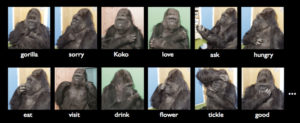
Koko picked up the ASL really fast and easily. Her learning curve was similar to human toddlers, with most progress within 2.5-4.5 years of age.
Koko was sophisticated in using the sign language. She could sign with phrase lengths of over 8 signs that included regular use of grammar.
Eventually Koko achieved vocabulary of more than 1000 words which is similar to a human toddler. She was believed to have an IQ of between 75 and 95 (the average IQ of a human is around 90 to 110). She also understood spoken English.
Koko Invented New Signs
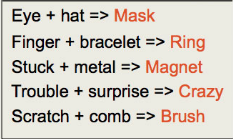
When she didn’t know the sign of what she wanted to say, she compounded 2 or more sign words that she already knew. e.g. to say ‘BRUSH’, she combined the sign for COMB with SCRATCH (SCRATCHCOMB).
Koko knew hundreds of nouns like toy, apple, dog and cookie. More striking was her usage of verbs. But to be able to express her mood and emotions, and know spatial relationships was the most remarkable trait she displayed.
Why is this an impressive feat?
Jeffery Kluger from Time magazine explains:
- No animal before her had been shown to grasp the concept of mood, emotion and spatial relation
- Koko’s ability to build sentences that clearly express her thoughts and meaning
- Koko signed to Dr. Patterson “You key there me cookie”. Here Koko was telling Dr. Patterson to unlock a cabinet and give her a treat. This sentence not only shows clarity but the use of “You”, and “there” which shows a point in three dimensional space.
Koko breached the language barrier
What seprates humans from all other species? Speech !
Our ability to talk is what makes us special thus more advanced than the animals. Evolution gave us components needed for speech: vocal cords, a palate, a tongue and lips that could produce such an infinitely varied array of sounds.
Koko could “speak” via a special computer and answered about a dozen inquiries in 45 minutes. Koko also showed new vocalizations. She expressed emotions such as frustrated, happy, anger and more by clear sounds such as hoots, purrs, cries, chuckles etc.
The reporters were present in the Gorilla Foundation Kitchen to monitor rather confirm if Koko could really talk, sign and answer questions. To their astonishment, Koko talked about apple juice, her favorite foods, her pet cats, her dreams, and even her personal aspirations.
Koko Stunned the Scientists by Playing Wind Instruments
In 2012, the scientists were shocked to see that Koko could play wind instruments like the recorder, harmonica and party-favor whistles. This achievement showed not only Koko’s sharp mind but more importantly it meant that she learnt to control her breathing, an act that has been believed to be beyond primates’ skill level (NPR reported).
Koko sheds light on the ability of other animals to assemble words into thoughts
Since Koko, numerous other animals have been reported to display understanding and assembling of thoughts into sentences:
- Kanzi (37-year-old bonobo): understands hundreds of lexigrams for words and actions. He makes sentences by pointing out the correct symbol on a screen.
- Chaser (14-year-old border collie): knows the name of 1,022 objects and can retrieve them on command.
- Alex (31-year-old gray parrot): had a vocabulary of 150 words and the same ability as Koko and Kanzi to assemble words into thoughts and sentences. Usually parrots only mimics words and sentences but Alex showed the remarkable ability of grasping the concept of language. This shows intelligence. He died in 2007.
Koko – A Celebrity
Koko embraced the media stardom. In June 1998, Koko impressed the world with her public interview in which at least 8000 America Online members swamped her with more than 13,000 questions.
In 2001, Robin Williams was invited to meet Koko and they became good friends within minutes. 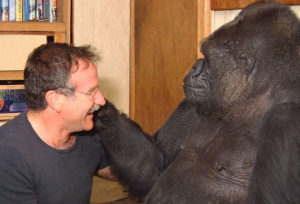 They both had cheered up each other and Koko even was smiling. Bill Chappell for National Public Radio reports, “Koko made a fast friend in comedian Robin Williams, trying on his glasses, showing him around, and getting him to tickle her. Then they made faces at each other.”
They both had cheered up each other and Koko even was smiling. Bill Chappell for National Public Radio reports, “Koko made a fast friend in comedian Robin Williams, trying on his glasses, showing him around, and getting him to tickle her. Then they made faces at each other.”
This meeting is an ultimate example of humans and gorillas embracing differences and expressing empathy for each other.
Considering what is happening at this time in the world, we could learn a lot from this meeting. If an animal and a human can forget their differences, then why not humans from various parts of the world and thus live peacefully. This was a very powerful message that Koko delivered unknowingly to the world.

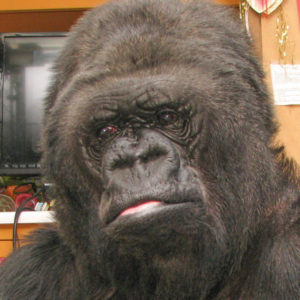
On August 11, 2014 Robin Williams passed away. When Dr. Patterson told Koko of this news, she became very quiet and thoughtful. Look at her sad expression on the right after the news sank in. Koko signed to Penny: “CRY LIP” (LIP is Koko’s sign for woman).
Over the years, she has played and befriended other celebrities like DiCaprio, William Shatner, Betty White and Mr. Rogers. She would run around with William’s eye glasses, unzip Mr. Roger’s famous Cardigans. This showed that an ape could be loving who wanted to be hugged and tickled.
Her impact has been profound and what she has taught us about the emotional capacity of gorillas and their cognitive abilities will continue to shape the world.
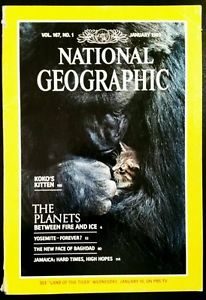
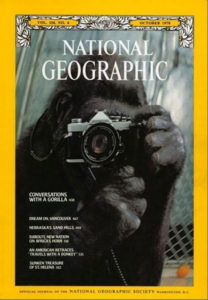
She has been featured in many documentaries and even on the cover of National Geographic twice. The first was in 1978, that showed the picture Koko took of herself in the mirror. The second one was in January 1985, included the story of Koko and her kitten, All Ball,” the first of many kittens and cats who were Koko’s companions.
Koko’s Kitten
Koko’s favorite picture book stories were “The Three Little Kittens” and “Puss ‘n’ Boots.” In 1983, she asked for a kitten for a Christmas present. She was given a life-like stuffed animal but she refused to play with it. She was very upset and kept signing “sad.”
That year on her birthday, Koko was allowed to choose a kitten from several in a litter. She chose a Manx that was tail less and looked like a ball. As we know, Koko loved to rhyme words in sign language, she named the cat “All Ball.”
Koko babied “All Ball” and both of them played with each other and she even tried to nurse the cat once. The cat reacted to Koko as if she was a human. All Ball was pretty independent and would wiggle out of Koko’s arms or bite her as a result of being ‘over babied.’ At that point, Koko would sign ‘obnoxious’.
Tragedy Strikes
Six months later, “All Ball” was tragically hit by a car and died. Once again Koko’s reaction completely mystified the scientists and researchers. The moment she heard the news, “she started whimpering — a distinct hooting sound that gorillas make when they are sad. We all started crying together,” Ron Cohn, a scientist with the Gorilla Foundation told LA Times.
After a while, Koko folded her hands on the side of her head and said, “Sleep. Cat.”
Koko mourned the death of her beloved pet “All ball” and expressed her grief in the same manner as humans do. She used to sign “Cat, cry, have-sorry, Koko-love, unattention, visit me.”
Throughout her life (after All Ball), Koko adopted several felines, gave them names like Lipstick and Smoky. She was gifted a box of kittens on her 44th birthday.
Children’s book “Koko’s Kitten”
Dr. Patterson wrote and published the book on Koko’s kitten. This continues to be used in elementary schools worldwide. The Gorilla Foundation states, “Koko’s impact has been profound and what she has taught us about the emotional capacity of gorillas and their cognitive abilities will continue to shape the world.”
What Else Can Koko Do?
- Using a Pen: Other than the sign language, Koko also used a pen for communication namely: select food
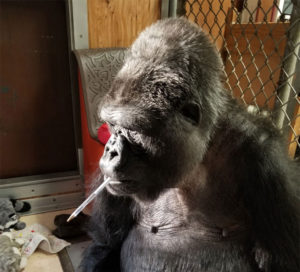 choices, sketching to tell what she wants. She had multiple means for expressing herself – art and movies, books,
choices, sketching to tell what she wants. She had multiple means for expressing herself – art and movies, books, 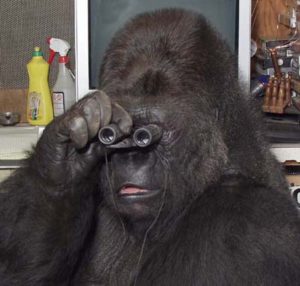 phrase cards and of course sign. All of these helped Koko clearly express her needs, thoughts and feelings.
phrase cards and of course sign. All of these helped Koko clearly express her needs, thoughts and feelings. - Exploration of her world: Koko loved to look into telescopes and microscopes and binoculars.
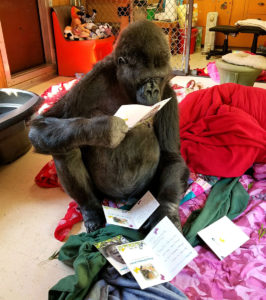
- Koko loved to read birthday cards addressed to her. She was reading since she was a baby gorilla. Dr. Patterson read the cards to her while signing. Koko indicated the that cards she liked best by kissing them, and handing them to Penny.
- Loved to dress up for a party:
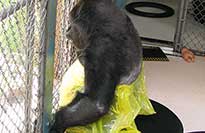 Koko whipped this outfit together in a hurry, she used a table cloth and designed it herself!
Koko whipped this outfit together in a hurry, she used a table cloth and designed it herself! - Napping with her baby doll:
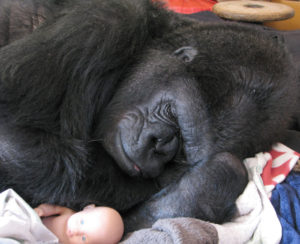 blissfully napping with her baby doll.
blissfully napping with her baby doll. - Selecting Films to watch: Her favorite movie was “Tea With Mussolini” (1999 drama starring Cher and Judi Dench as women who raise a young boy in 1930s fascist Italy).
- The List Goes on……
Koko’s Friends
Michael
Another western lowland gorilla named Michael was brought to the Foundation for two reasons: (i) To expand the project (ii) a potential mate for Koko.
However, Koko treated him like a brother and not as a mating partner. They both became close friends. Michael also learned ASL like Koko. He was known for his painting skills.
As a baby, he was captured by poachers in Cameroon. They killed his mother. Dr. Patterson and other Gorilla Foundation staff believe he tried several times to describe how he was captured.
He died on April 19, 2000 from a sudden heart attack.
Once again Koko grieved for months. She did not smile for 6months until she had a meeting with Robin Williams who made her smile.
Nadume
In 1991, another 400-pound male gorilla called Ndume was brought to the Gorilla Foundation. Koko chose him from a number of available male gorillas through “video dating“. He became the Co-Ambassador with Koko. They got along extremely well but there was no mating behavior displayed by either of them.
The main reason could be the fact that in natural habitat of gorillas, there are multiple females for each male. In the Foundation Koko was the only female with Ndume.
Nadume was known as the Gorilla who threw poop on his caregivers in Cincinnati.
Koko’s Pursuit for a Baby
For more than two decades, it has been the Gorilla Foundation’s goal for Koko to have a baby so that she can teach her child sign language. Koko has told them for years how she wants to have a baby. She played with her dolls as “practice for motherhood,”
The foundation’s website says that while Koko is frustrated about her lack of baby, she is not giving up on “her dream.”
Criticism of human like behavior of Koko
Behavioral scientists have expressed skepticism over language claims regarding Koko. Herb Terrace (Founder of the Chimpanzee Language Experiment Project Nim) has been the most vocal critic. He claimed Koko was only mimicking the actions of people working with her which he published in paper entitled “Why Koko can’t talk” in 1982.
Dr. Terrace went to the extreme of saying that ape signing is only “involuntary demands for primary rewards.” All of his views were based on his own experience with Nim (a smart and engaging chimpanzee). His full name was Neam Chimpsky or Nim for short. Project Nim ended in 1977, the conclusion in nutshell in Dr. Terrace’s words was: “Simians lack what is called a “theory of mind”—the ability to perceive what another simian is thinking. Unlike human language, which is conversational, an ape’s only expectation when signing is a reward.”
Consequences of Negative “Opinions” on Science
These kind of ‘opinions’ and eagerness to deny what Koko had achieved made it harder for ape language studies to get funding. This had dire negative consequences on the researchers that were shunned by the scientific community and were even forced to abandon their animal subjects.
Contradictions to Herb Terrace’s Conclusions
Large scale research was carried out after Terrace published a paper in the Journal Science (1979) titled ” Can an Ape Create a Sentence?” that contradicts his conclusions.
Chris O’Sullivan and Carey Yeager findings with Nim were different than those of Terrace. They found that Nim used sign language frequently when he was placed in an informal setting. This is in contrast to the formal training setting that Terrace imposed on Nim.
Their conclusion was “Terrace failed to understand that children (and presumably chimps raised as children) absorb language in an environment where language is used“.
‘Washoe‘ was the first chimpanzee that was taught to sign by Roger and Deborah Fouts. They showed that Washoe herself taught signs (sign language) to her adopted child, Loulis and other chimpanzees she lived with. It was seen they all also signed to each other when no humans were present.
Roger and Deborah Fouts later showed that Washoe, the first chimpanzee to be taught to sign, herself taught signs to her adopted child, Loulis. Washoe and the chimpanzees with whom she lived also signed to each other when no humans were present.
More recently, Janni Pedersen and William Fields have analyzed a videotape of a conversation between Savage-Rumbaugh and Panbanisha [bonobo at Great Ape Trust of Iowa] . Their findings have been published in a peer reviewed journal, are in direct contradiction to what Terrace claims.
They conclude that the bonobos at [Great Ape Trust of Iowa] have linguistic abilities with dimensions. This means they can make conversation like humans. Although it has been noted that great apes are not interested in chit chatting like humans.
In a way, a strong rejection of the idea that apes can sign spontaneously by Dr. Terrace reinforces our belief in the uniqueness of our own species.
Dr. Patterson’s Perseverance to her Project (Koko)
Dr. Patterson’s love for Koko and Science did not let her abandon her project and the great ape. Instead she took Koko to Woodside in 1979. This is where Koko has lived since in a wooded sanctuary.
I as a scientist admire Dr. Patterson’s life and courage for what she has accomplished with Koko. Not only the scientific community but also the rest of the world will reap the rewards in innumerable ways. How many of us can actually do what Dr. Patterson did? It’s easy to criticize of course but to carry out such a project with such dedication is the spirit of a true scientist.
Today’s scientists could certainly learn from lives of Koko and Dr. Patterson, what it means to be a real scientist: “Have an open mind and never stop being curious” as Einstein said.
What has Koko given to humans
Project Koko has been extremely beneficial for humans:
(i) beyond the satisfaction of scientific discovery, and
(ii) the thrill of “talking with animals.”
Teachers report that
- young students exposed to “Koko and Michael” and to Dr.Patterson’s and Cohn’s presentations and studies are extremely motivated to learn more about other species.
- They also understand that all of us have responsibilities to other species.
- Quite a few students have also decided to pursue careers in science and/or conservation as a result of this exposure.
- This is extremely essential in order for the lessons of Project Koko to be fully realized and extended for the benefit of all great apes.
Koko has also shown to the American public that the great apes don’t have to be scary but they also desire love and companionship and that they possess qualities like empathy.
Rest in Peace Koko!